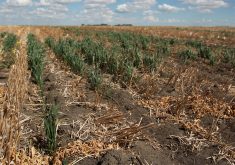Southeast Saskatchewan is sole bright spot in durum growing areas
SASKATOON — The latest U.S. durum production estimate could be a harbinger of what’s to come in Canada, says an analyst.
The U.S. Department of Agriculture is now forecasting 2.09 million tonnes of U.S. production, down 14 percent from its July estimate.
Read Also

House ag committee to undertake several studies
The House of Commons standing agriculture committee has set its agenda for the coming months. Members began the fall sitting with a two-hour update on international trade
GrainFox chief analyst Neil Townsend thinks Canada’s crop will also be a disappointment.
He is estimating six million tonnes of production, down 20 per cent from his initial forecast of 7.5 million tonnes.
That is in line with the International Grains Council’s latest estimate of 6.1 million tonnes.
“In Canada, we have good conditions in southeast Saskatchewan, but the rest of the durum area has definitely been hurt by prolonged heat and dryness, and that lightened the crop and reduced yields,” he said.
Earlier this year he was forecasting a combined 10.5 to 11 million tonnes of production from the two countries, but now it’s looking more like eight million tonnes.
That vastly reduced production outlook has “stopped the bleeding” in durum markets, but it is still far from a bullish outlook because of the rise of Russia and Turkey as major players in the durum market.
The upshot is that the bottom of the market will not be as low as it would have been if Canada and the U.S. had bumper crops on the way.
However, he still thinks most of Canada’s new crop durum will be sold in the high-$7 to mid-$8 per bushel range unless there is a big move in the corn or wheat markets.
The good news is that Russia and Turkey won’t be as much of a competitive threat as they were last year.
Russia’s durum area has been excessively wet, so its exports could fall.
Meanwhile, Turkey is expected to export about 1.05 million tonnes of the crop, down from 1.6 million tonnes last year.
“That would be helpful to Canada, but we need every shred of business we can get,” said Townsend.
He thinks Canada will need to export five million tonnes of durum in 2024-25, up from four million tonnes this year.
One factor playing into Canada’s favour is that the crop will not be all No. 1 and No. 2 quality this year.
“This might be a little counterintuitive, but that makes it a bit easier to trade,” said Townsend.
There are plenty of customers who want cheaper No. 3, No. 4 or No. 5 quality durum.
Another bullish factor for Canadian farmers is that Mexico’s durum growers continue to struggle with drought.
“People were a little bit surprised that they weren’t involved in the last Algerian tender,” he said.
“They just don’t have the volumes to be offering.”
That could push 200,000 to 300,000 tonnes of export demand towards Canada and the U.S.
However, the big overarching problem in the durum market is that buyers know there is plenty of supply available because Turkey has emerged out of nowhere to become a fierce competitor in the export market.
There is now more durum trying to find a home than there are people wanting to buy it, he said.


















